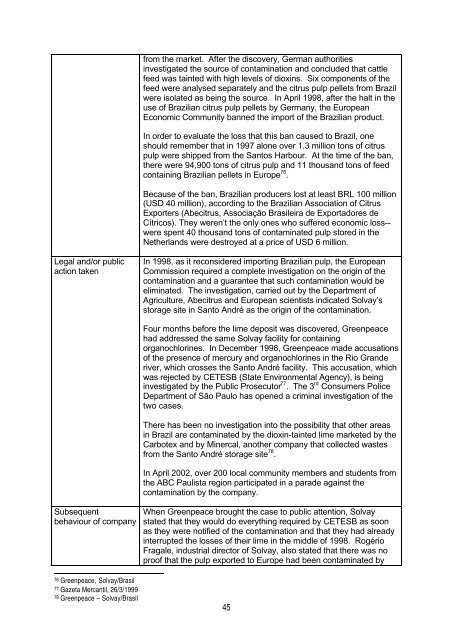Umweltverbrechen multinationaler Konzerne - Greenpeace
Umweltverbrechen multinationaler Konzerne - Greenpeace
Umweltverbrechen multinationaler Konzerne - Greenpeace
Erfolgreiche ePaper selbst erstellen
Machen Sie aus Ihren PDF Publikationen ein blätterbares Flipbook mit unserer einzigartigen Google optimierten e-Paper Software.
Legal and/or public<br />
action taken<br />
Subsequent<br />
behaviour of company<br />
76 <strong>Greenpeace</strong>, Solvay/Brasil<br />
77 Gazeta Mercantil, 26/3/1999<br />
78 <strong>Greenpeace</strong> – Solvay/Brasil<br />
from the market. After the discovery, German authorities<br />
investigated the source of contamination and concluded that cattle<br />
feed was tainted with high levels of dioxins. Six components of the<br />
feed were analysed separately and the citrus pulp pellets from Brazil<br />
were isolated as being the source. In April 1998, after the halt in the<br />
use of Brazilian citrus pulp pellets by Germany, the European<br />
Economic Community banned the import of the Brazilian product.<br />
In order to evaluate the loss that this ban caused to Brazil, one<br />
should remember that in 1997 alone over 1.3 million tons of citrus<br />
pulp were shipped from the Santos Harbour. At the time of the ban,<br />
there were 94,900 tons of citrus pulp and 11 thousand tons of feed<br />
containing Brazilian pellets in Europe 76 .<br />
Because of the ban, Brazilian producers lost at least BRL 100 million<br />
(USD 40 million), according to the Brazilian Association of Citrus<br />
Exporters (Abecitrus, Associação Brasileira de Exportadores de<br />
Cítricos). They weren’t the only ones who suffered economic loss-were<br />
spent 40 thousand tons of contaminated pulp stored in the<br />
Netherlands were destroyed at a price of USD 6 million.<br />
In 1998, as it reconsidered importing Brazilian pulp, the European<br />
Commission required a complete investigation on the origin of the<br />
contamination and a guarantee that such contamination would be<br />
eliminated. The investigation, carried out by the Department of<br />
Agriculture, Abecitrus and European scientists indicated Solvay’s<br />
storage site in Santo André as the origin of the contamination.<br />
Four months before the lime deposit was discovered, <strong>Greenpeace</strong><br />
had addressed the same Solvay facility for containing<br />
organochlorines. In December 1998, <strong>Greenpeace</strong> made accusations<br />
of the presence of mercury and organochlorines in the Rio Grande<br />
river, which crosses the Santo André facility. This accusation, which<br />
was rejected by CETESB (State Environmental Agency), is being<br />
investigated by the Public Prosecutor 77 . The 3 rd Consumers Police<br />
Department of São Paulo has opened a criminal investigation of the<br />
two cases.<br />
There has been no investigation into the possibility that other areas<br />
in Brazil are contaminated by the dioxin-tainted lime marketed by the<br />
Carbotex and by Minercal, another company that collected wastes<br />
from the Santo André storage site 78 .<br />
In April 2002, over 200 local community members and students from<br />
the ABC Paulista region participated in a parade against the<br />
contamination by the company.<br />
When <strong>Greenpeace</strong> brought the case to public attention, Solvay<br />
stated that they would do everything required by CETESB as soon<br />
as they were notified of the contamination and that they had already<br />
interrupted the losses of their lime in the middle of 1998. Rogério<br />
Fragale, industrial director of Solvay, also stated that there was no<br />
proof that the pulp exported to Europe had been contaminated by<br />
45

















